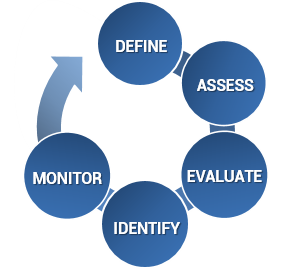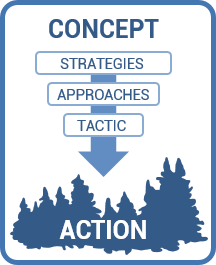
What is it?
The Adaptation Workbook is a structured process to consider the potential effects of climate change and design land management and conservation actions that can help prepare for changing conditions. The process is completely flexible to accommodate a wide variety of geographic locations, ownership types, ecosystems and land uses, management goals, and project sizes. The Workbook consists of 5 basic steps:
- Define goals and objectives
- Assess climate impacts and vulnerabilities
- Evaluate objectives considering climate impacts
- Identify adaptation approaches and tactics for implementation
- Monitor effectiveness of implemented actions
Use the workbook with us! Considering taking one of our 7-week guided online trainings using your own real-world project!
Why was it created?
More and more information is becoming available on climate change projections and potential impacts on natural resources and agriculture. Unfortunately, most of this information doesn't seem applicable because many land owners and managers are unsure how climate change might actually apply at the scales that are relevant to their work. The Adaptation Workbook was created to bridge this gap. The Workbook provides users with a flexible, logical process to consider climate change information and design customized management actions that can help achieve their management objectives.
The Workbook was created by the Northern Institute of Applied Climate Science, a collaborative, multi-institutional partnership led by the USDA Forest Service, and this process is described in Forest Adaptation Resources: Climate change tools and approaches for land managers, 2nd Edition. Complete information about the Workbook and the Climate Change Response Framework is available in that publication. The Workbook is also available for agriculture, which is described in Adaptation Resources for Agriculture: Responding to Climate Variability and Change in the Midwest and Northeast.
Who’s it for?
The Workbook can be used by a diverse range of people working in forestry, natural resources, and agriculture, including biologists, foresters, planners, soil conservationists, and consultants. The Workbook is designed primarily for professionals, but motivated landowners will also be able to use it. People with clear management goals and knowledge about their local ecosystems can use the Workbook, whether they are making management decisions for individual parcels or across a broad landscape.
- See real-world examples of how natural resources professionals, land managers, and landowners have used the Adaptation Workbook to consider climate change in their management at ForestAdaptation.org/demos.
- Find real-world examples of how farmers and producers have used the Agriculture Adaptation Workbook on the USDA Climate Hubs website.
Learn more about the Adaptation Workbook

These resources provide more detailed information about the Adaptation Workbook, and you'll also find detailed examples of how the process has been used in many real-world projects:
- Swanston, Chris; Janowiak, Maria, eds. 2016. Forest Adaptation Resources: Climate change tools and approaches for land managers, 2nd Edition. Gen. Tech. Rep. NRS-87-2. Newtown Square, PA: U.S. Department of Agriculture, Forest Service, Northern Research Station.161 p.
- Menus of Strategies and Approaches used in Step 4 of the Adaptation Workbook.
- Janowiak, Maria K.; Swanston, Christopher W.; Nagel, Linda M.; Brandt, Leslie A.; Butler, Patricia R.; Handler, Stephen D.; Shannon, P. Danielle; Iverson, Louis R.; Matthews, Stephen N.; Prasad, Anantha; Peters, Matthew P. 2014. A practical approach for translating climate change adaptation principles into forest management actions. Journal of Forestry. 112(5): 424-433.
- Janowiak, M.; Dostie, D.; Wilson, M.; Kucera, M.; Skinner, R.H.; Hatfield, J.L.; Hollinger, D.; Swanston, C. 2016. Adaptation Resources for Agriculture: Responding to Climate Variability and Change in the Midwest and Northeast. Washington, DC: U.S. Department of Agriculture. 70 p.
Climate information used in the Workbook:
The Adaptation workbook asks land-owners and natural resource professionals to think critically. You'll consider the implications of climate change on your property using your expertise, knowledge and judgment. To assist this part of the process, the Adaptation Workbook provides users with climate impact statements specific to their region. When you get this information for your own property or project area, you'll be prompted to interpret, evaluate, and comment on how large-scale regional impacts will affect your local area and your management objectives.
- Regional climate information, and forest ecosystem vulnerability are provded for much of the Midwest and Northeast and are from these documents. Statements are drawn from the Climate Change Response Framework peer-reviewed documents.
- For areas outside of the Midwest and Northeast (including Alaska and Hawaii), regional information is drawn from the National Climate Assessment (NCA) and the many supporting peer-reviewed documents used to create the NCA to provide some climate impact statements for all regions of the U.S. All climate statements have citations and links to the resource for further reading.
Explore climate impacts presented in the Adaptation Workbook.
Acknowledgments
This effort is a joint product of the USDA Northern Forests Climate Hub and the Northern Institute of Applied Climate Science, a collaborative, multi-institutional partnership led by the USDA Forest Service and comprised of federal, forest sector, conservation, higher education, and tribal organizations. The NIACS partnership provides integral support to the USDA Northern Forests Climate Hub and serves to bring together partners with diverse perspectives to achieve shared goals.
This work is supported in part by the USDA Forest Service, USDA Climate Hubs, and American Forests.
